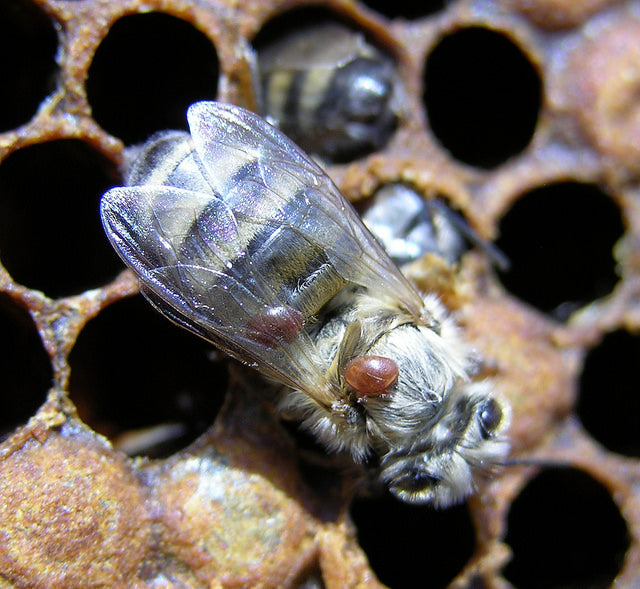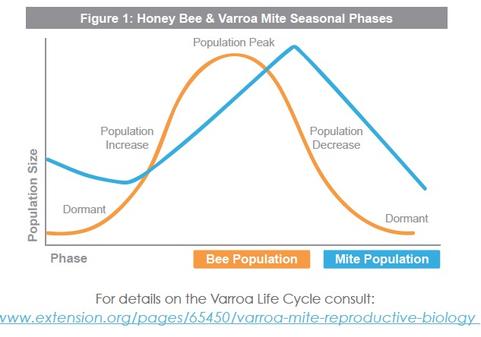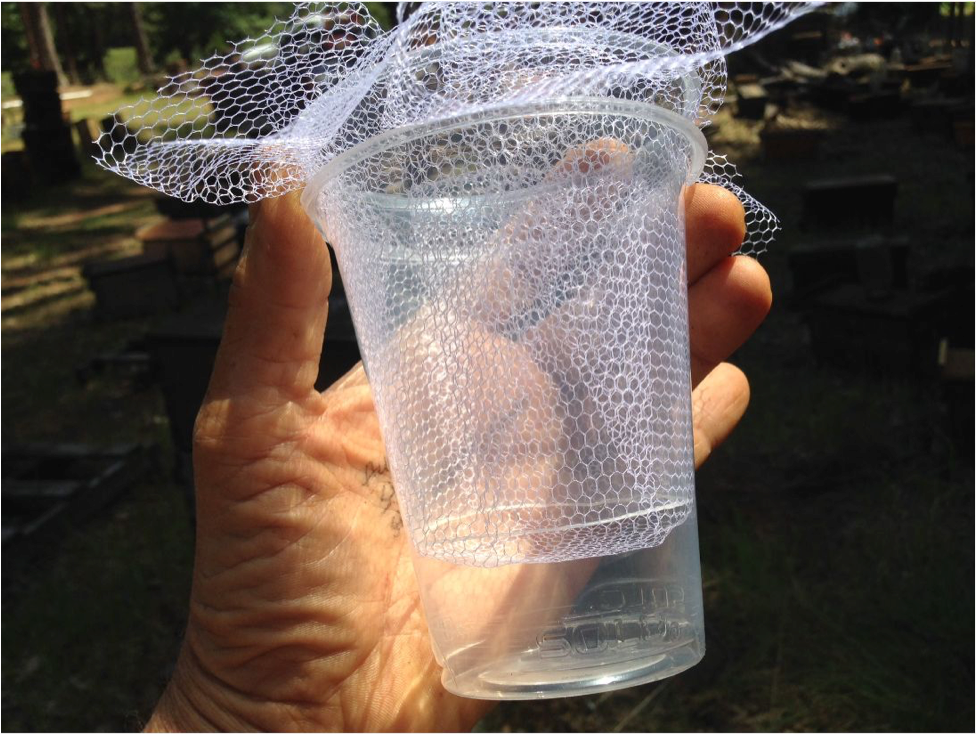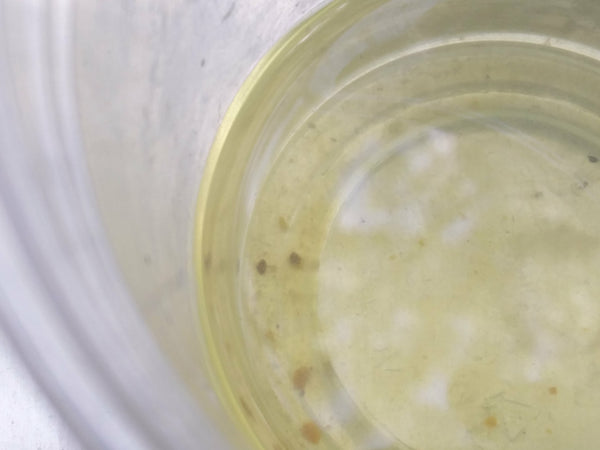Varroa Mites
BEEKEEPING SERIES: Integrated Pest Management
INTEGRATED PEST MANAGEMENT and VERROA MITES
Varroa Mites are the biggest pest threat to honeybees. So much so that most bee conventions you go to focus more on the mites than the bees! Randy Oliver said at the recent Texas Beekeepers Association clinic that it's almost as if we are raising varroa mites, not raising bees. Mites are also a fact of life in the hive and the IPM strategy is ensuring that their numbers remain in check.

LIFE CYCLE OF VARROA MITES
To simplify things, we'll concentrate on the female - there are two stages: the phoretic stage and the reproductive stage. The phoretic stage is when the mite rides on adult bees - they can hop from one bee to another and transmit diseases. The phoretic stage lasts about 5-11 days when there is brood in the colony.
The other stage is the reproductive stage, which occurs only under the capped brood cell. The varroa mite invades a host (worker or drone larvae) cell just prior the cell being capped. Once inside, she will hide in the brood food in an upside-down position (viewed from the top of the cell). The first egg is laid 70 hours after cell capping. The first egg is not fertilized, and becomes a male. After this, approximately every thirty hours, the mite lays a female egg. A total of five (on worker pupae) or six eggs (on drone pupae) can be laid in a capped cell.
However, because worker bees will emerge about eleven days after capping, and drones fourteen days, but a daughter mite takes six days to mature, most of these eggs do not have time to develop into adults. The mites who are not fully developed, all die shortly due to dehydration after a cell is opened (after bee emergence, or uncapping by hygienic bees). Therefore only the mature, tanned female mites are seen by most beekeepers. Because of this phenomenon, varroa tend to prefer the larger drone brood (source: eXtenstion.org).
HOW TO MONITOR FOR VARROA MITES AND METHODS
Bee colonies can tolerate a low number of mites, but will decline or die as mite numbers rise. Accurately assessing and understanding mite population is the basis of an IPM control strategy. Beekeepers can assess mite populations during any of the phases of bee/mite population cycles. Generally, a beekeeper should perform Varroa monitoring assessments at least four times during the year, beginning with the Population Increase phase. During the Population Decrease phase, mite levels should be re-checked to confirm that mite numbers are low going into the Dormant phase. During the Dormant phase, sampling should continue, if possible (source: Honey Bee Health Coalition).

MONITORING METHODS FOR VARROA
There are many different ways that people monitor for varroa - at Bee2Bee, we give the option of two main ways (or, one can opt out if requested).
1. The Alcohol Wash
This involves shaking a frame of brood, collecting a half cup of bees (approximately 300 bees) and dunking them in alcohol.
Pros: considered the most accurate test, quick, not pricey
Cons: kills 300 bees, can accidentally kill queen if you are not careful
In previous years, Bee2Bee only used this test - complete with wire strainer and special viewing bowl. After attending the Texas Beekeepers Association Summer Clinic and seeing Randy Oliver's keynote - we are now employing the poor woman's version of the Mite Checkers sold on beekeeping websites: 2 plastic cups with a piece of tulle between.
 Pour the half cup of bees, swirl and voila - mites fall through the tulle to the bottom. Bonus: I'm using yellow tulle, because fashion.
Pour the half cup of bees, swirl and voila - mites fall through the tulle to the bottom. Bonus: I'm using yellow tulle, because fashion.
You then count the mites, divide by 3 and have the percentage of mites in the hive.

You may also knock off pollen and other bee bits - but in the above test, two mites were found. They are quite visible - rust colored and round. If you have good eyes, you'll even see their appendages.
For those that fret about killing bees, please keep in mind that up to 1500 bees die every day in a full colony. As one of my clients Aida says, "they'll make more."
2. The Sugar Roll Method
Here is quite the same method: shake a frame of brood into a tray, collect a half cup and put them in a jar with a tulle lid. Add 2 tablespoons of powdered sugar and roll to cover the bees. Set aside for 2 minutes. Shake vigorously onto a white tray for 60 seconds. Dissolve the sugar with water and you should be able to count mites. Replace bees into the hive.
Pros: Easy, doesn't kill bees
Cons: Slightly more time consuming, slightly messier, less accurate
The University of Minnesota Bee Squad did a great video on this mite check:
Bee Squad MiteCheck Test KitCheck out our Bee Squad MiteCheck Varroa Mite Testing Kit how to video! Monitor your mite levels and report them to www.mitecheck.com!
Posted by University of MN Bee Squad on Friday, July 7, 2017
Note: to test Top Bar Hives, we simply brushed bees off of 1-2 brood frames and employed the same methodology as a Langstroth.
TREATMENT FOR VARROA MITES
Depending on your testing - you may decide to treat (or not). We will discuss the pros and cons of various methods of treatment, including the natural treatment method, in future lessons. Stay tuned!
